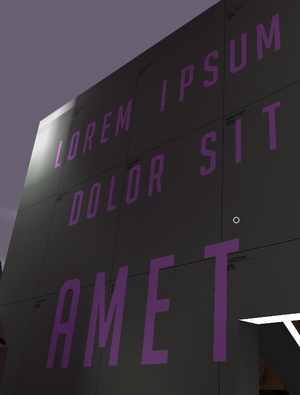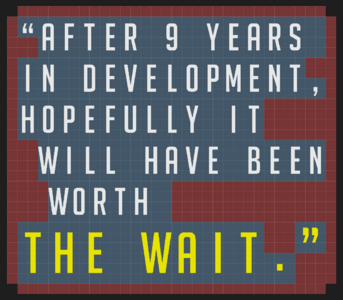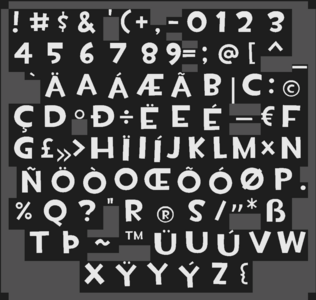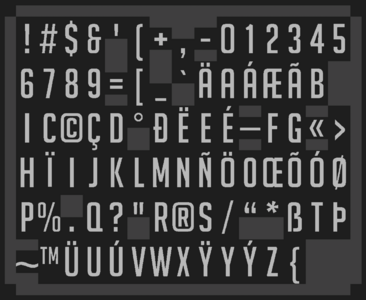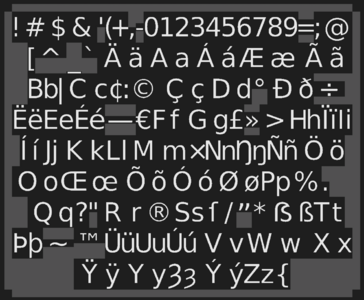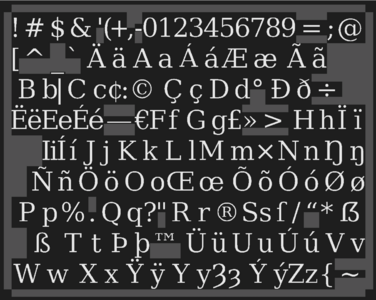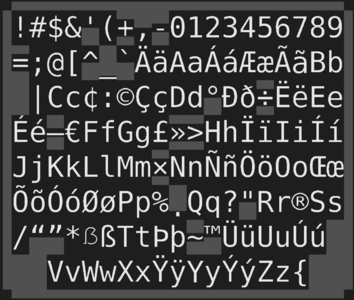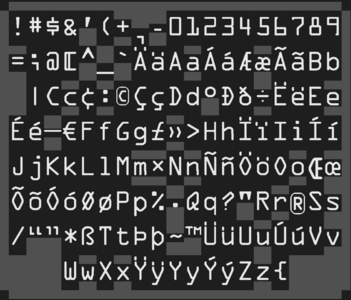Text Decals 4.0
Decals of lotsa characters to create arbitrary text, in (eventually) numerous fonts!
A buncha decals to let you create arbitrary text.
The pack contains the following fonts:
Installation: unzip to tf/materials/. You should be good to go.
Use: The decals only come in white. If you're fine with white, you can use 'em as decals/overlays just fine. If not, you can apply them to brush entities, adjust those entities' Color keyvalues, and then set the brushes such that the text faces are overlapping whatever you want the text to be on—such that they'd be z-fighting if the text textures didn't have $decal. Alternatively, you can go into the VMTs and set the $color variable.
For monospace fonts, like Big Noodle Titling, the spacing is basically done for you. For the others, unfortunately, you'll have to do the spacing yourself.
Relatedly, some symbols and punctuation, such as commas, are cut down by a factor of 2, since the rest is just empty space that takes up file size. In case it isn't obvious, these areas are indicated by the gray sections in the demos.
In many cases, the fact that VTFs must be a power of 2 on both sides means that there's still plenty of blank space in the characters. I recommend cutting the brushes down to reduce that, to improve optimization.
Credit: I mean… if you want. This wasn't a particularly skilled or high-effort creation. I'm only bothering to share it on the chance that it saves people time.
The pack contains the following fonts:
- Big Noodle Titling (used in certain Mann vs. Machine signs)
- Whatever basic serif, sans serif, and monospace fonts GIMP uses
- OCR-A (used in old contracts)
- TF2 Build (used in Engie's PDAs, among other places)
- Comic Sans
- Highway Gothic (used in U.S., Canadian, Latin American, and some Southeast Asian road signs)
- Impact (used in the General Industries Co. logo)
- Stencil (used for some text in the comics)
- TF2 Secondary (used for the "Critical Hit!!!" text and some UI bits)
- TF2 Professor (used in message-of-the-day chalkboards)
- Times New Roman
- Verdana Bold (the default font used in chat)
Installation: unzip to tf/materials/. You should be good to go.
Use: The decals only come in white. If you're fine with white, you can use 'em as decals/overlays just fine. If not, you can apply them to brush entities, adjust those entities' Color keyvalues, and then set the brushes such that the text faces are overlapping whatever you want the text to be on—such that they'd be z-fighting if the text textures didn't have $decal. Alternatively, you can go into the VMTs and set the $color variable.
For monospace fonts, like Big Noodle Titling, the spacing is basically done for you. For the others, unfortunately, you'll have to do the spacing yourself.
Relatedly, some symbols and punctuation, such as commas, are cut down by a factor of 2, since the rest is just empty space that takes up file size. In case it isn't obvious, these areas are indicated by the gray sections in the demos.
In many cases, the fact that VTFs must be a power of 2 on both sides means that there's still plenty of blank space in the characters. I recommend cutting the brushes down to reduce that, to improve optimization.
- for most characters, the texture name is <character><fontName>.vmt. Big Noodle Titling pack's A file, for example, is at overlays/text/Big Noodle/A_bigNoodle.vmt. In mixed-case fonts, the lowercase letters are <character>_l<fontName>.vmt, while the uppercase ones are <character>u<fontName>.vmt. I had to make some concessions, however, for the rarer characters.
- for characters with diacritics, the character is paired with a letter depending on the diacritic:
- for acute accents, it's just the letter but lowercase. (this is a reference to the apex, which was used in Latin to indicate long vowels before acutes and macrons were a thing.) Á is at overlays/text/Big Noodle/Aa_bigNoodle.vmt.
- for diæreses/umlauts, it's -e. (this is because the umlaut was created as a scribal abbreviation to indicate that the vowel was followed by an e. also because AE, Ee, and OE are separate things.) Ä is at overlays/text/Big Noodle/A-e_bigNoodle.vmt.
- for tildes, it's n. (this is because tildes arose as a scribal abbreviation indicating that the letter was followed by an n.) Ã is at overlays/text/Big Noodle/An_bigNoodle.vmt.
- for graves, it's `. currently, this only applies to TF2 Build's Ò, because a) nobody's asked me for any, b) I only added Ò because it's in the Claidheamh Mòr's name, and c) the other fonts' Ós can just be applied backwards.
- Æ and Œ are AE and OE, respectively.
- Þ and Ð are at Th and Dh, respectively. (it's because both make the English "th" sounds, but Ðð is often transliterated as "dh.")
- Ç and ß are at Cz and Sz, respectively. (for Ç, this is because Çç is derived from Visigothic z. ß is the eszett, whose origins are bizarrely unclear but whose name strongly suggests it's a ligature of the long s ſand z.)
- while the capital eszett ẞ is Sz_u in mixed-case fonts, the lower-/single-case one is always plain Sz.
- Ŋ is "ng," because that's literally the sound it's made for. (in some fonts, the capital form looks more like a giant letter N, e.g., Ŋ.)
- and then there's a long list of random characters referred to by abbreviations:
- £ and € are "GBP" and "EUR," respectively.
- % is "prc" (for percent), because while it's a valid filename character that's on most keyboards, Hammer can't seem to process it as part of a texture name.
- * is "str" (for asterisk or star).
- / is "sls" (for slash).
— Ø is "osl" (for o-slash). - > is "grt" (for greater). for the "less than" symbol, just flip it around.
- the full stop . is "prd" (for period).
- ? is "qmk" (for question mark). Spanish question marks ¿ can be obtained by rotating it 180°.
- the double quote " is "qot" (for quote). (the single quote ' works just fine as a filename.)
— the opening double smart quote “ is "sqt-l." the closing double smart quote ” is "sqt-r." - » is "gmt" (for guillemet).
- the em dash — is, naturally, "em."
- © is "cpr" (for copyright).
- ® is "rr" (for rights reserved).
- ™ is, naturally, "tm."
- | is "bar."
- ~ is "tld" (for tilde).
- ° is "deg" (for degree).
- : is "col" (for colon).
- Ȝ is "gh" ('cuz that's what generally replaced it).
Credit: I mean… if you want. This wasn't a particularly skilled or high-effort creation. I'm only bothering to share it on the chance that it saves people time.
- License
- Free to use and modify.


